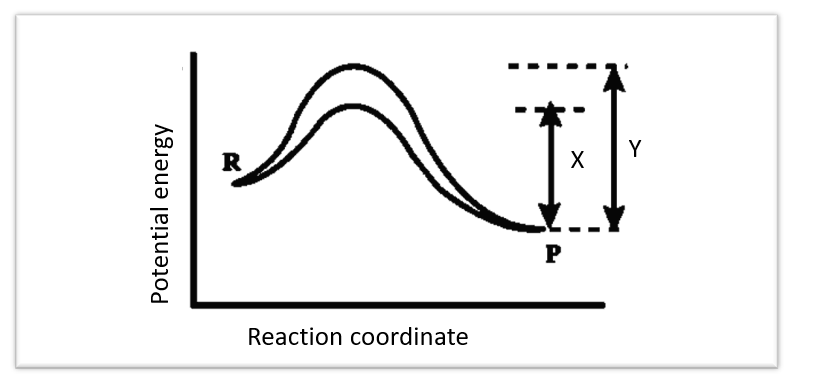
The graph of the effect of catalyst on activation energy is given below. Fill up the blanks X and Y with appropriate statements.

A.X = energy of activation without catalyst, Y = energy of activation with catalyst
B.X = path of reaction with catalyst, Y = path of reaction without catalyst
C.X = energy of activation with catalyst, Y = energy of activation without catalyst
D.X = energy of endothermic reaction, Y = energy of exothermic reaction

Answer
569.7k+ views
Hint: Activation energy is a physical quantity that can be understood as the minimum amount of energy that must be provided to a system for the reaction in the system to start. To put it in simpler terms, it is the energy push to push the reaction in the forward direction.
Complete step by step answer:
-The graph that has been given to us is known as the activation energy graph. To get the meanings of the given variables X and Y, we must first learn to read the graph properly. To read the graph properly, we must first look at both the axes and try to understand the values that are being represented on these axes.
-We can see that the y axis represents the potential energy of the reaction. Now the meaning of potential energy may differ slightly from the meaning that we have learnt in physics. In this context, the potential energy axis represents just the energy state of the reaction. the difference in this potential energy can thus calculate the difference in the energy states at any two points in the reaction.
-The x axis on the other hand represents the reaction coordinate. This axis basically marks the various states that the reactants and products go through during the course of the reaction. This axis is time independent.
-Hence, while reading the curves represented on the graph, we can understand that they are speaking about the variation in the potential energy at any step in the reaction. the difference in the potential energy can be accounted as the activation energy of the reaction.
-Thus, X represents a lower activation energy while Y represents a higher activation energy. The use of catalyst reduces the activation energy, since it acts as a promoter of the reaction.
Hence, we can say that X = energy of activation with catalyst, Y = energy of activation without catalyst.
Hence, Option C is the correct option.
Note:
High activation energy can be understood as higher energy required to achieve a successful collision between the particles. A good example for this could be combustion. Even though combustion is an exothermic reaction, because of the high activation energy it requires heat. The particle gains enough energy from heat to overcome the barrier of activation energy.
Complete step by step answer:
-The graph that has been given to us is known as the activation energy graph. To get the meanings of the given variables X and Y, we must first learn to read the graph properly. To read the graph properly, we must first look at both the axes and try to understand the values that are being represented on these axes.
-We can see that the y axis represents the potential energy of the reaction. Now the meaning of potential energy may differ slightly from the meaning that we have learnt in physics. In this context, the potential energy axis represents just the energy state of the reaction. the difference in this potential energy can thus calculate the difference in the energy states at any two points in the reaction.
-The x axis on the other hand represents the reaction coordinate. This axis basically marks the various states that the reactants and products go through during the course of the reaction. This axis is time independent.
-Hence, while reading the curves represented on the graph, we can understand that they are speaking about the variation in the potential energy at any step in the reaction. the difference in the potential energy can be accounted as the activation energy of the reaction.
-Thus, X represents a lower activation energy while Y represents a higher activation energy. The use of catalyst reduces the activation energy, since it acts as a promoter of the reaction.
Hence, we can say that X = energy of activation with catalyst, Y = energy of activation without catalyst.
Hence, Option C is the correct option.
Note:
High activation energy can be understood as higher energy required to achieve a successful collision between the particles. A good example for this could be combustion. Even though combustion is an exothermic reaction, because of the high activation energy it requires heat. The particle gains enough energy from heat to overcome the barrier of activation energy.
Recently Updated Pages
Master Class 12 Business Studies: Engaging Questions & Answers for Success

Master Class 12 Economics: Engaging Questions & Answers for Success

Master Class 12 English: Engaging Questions & Answers for Success

Master Class 12 Maths: Engaging Questions & Answers for Success

Master Class 12 Social Science: Engaging Questions & Answers for Success

Master Class 12 Chemistry: Engaging Questions & Answers for Success

Trending doubts
What are the major means of transport Explain each class 12 social science CBSE

Which are the Top 10 Largest Countries of the World?

Draw a labelled sketch of the human eye class 12 physics CBSE

How much time does it take to bleed after eating p class 12 biology CBSE

Explain sex determination in humans with line diag class 12 biology CBSE

Differentiate between homogeneous and heterogeneous class 12 chemistry CBSE




